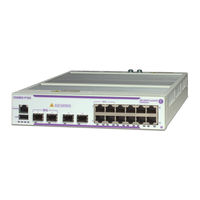Alcatel-Lucent OmniSwitch 6900 Series Manuals
Manuals and User Guides for Alcatel-Lucent OmniSwitch 6900 Series. We have 1 Alcatel-Lucent OmniSwitch 6900 Series manual available for free PDF download: Network Configuration Manual
Alcatel-Lucent OmniSwitch 6900 Series Network Configuration Manual (1078 pages)
OmniSwitch AOS Release 8
Brand: Alcatel-Lucent
|
Category: Switch
|
Size: 11.3 MB
Table of Contents
-
-
-
How It Works62
-
-
-
-
-
-
In this Chapter108
-
-
-
In this Chapter125
-
-
How MSTP Works135
-
-
-
-
-
-
In this Chapter175
-
LBD Defaults176
-
-
-
LBD Overview178
-
Configuring LBD181
-
-
-
-
-
ERP Defaults240
-
ERP Overview241
-
-
-
In this Chapter239
-
-
-
MVRP Defaults266
-
MRP Overview268
-
MVRP Overview268
-
Configuring MVRP271
-
-
-
In this Chapter265
-
-
-
802.1AB Overview281
-
-
-
In this Chapter278
-
-
-
In this Chapter293
-
-
Interoperability299
-
-
-
-
-
In this Chapter309
-
IP Defaults311
-
IP Overview312
-
IP Protocols312
-
-
IP Forwarding314
-
Distributed ARP324
-
IP Configuration327
-
Managing IP340
-
VRF Route Leak348
-
-
-
VRF Defaults352
-
-
VRF Profiles358
-
-
-
Configuring Ipv6
388 -
-
In this Chapter400
-
Ipsec Defaults401
-
Ipsec Overview404
-
-
-
-
In this Chapter423
-
RIP Defaults424
-
RIP Overview426
-
RIP Version 2427
-
-
RIP Routing428
-
RIP Options431
-
RIP Security440
-
-
-
In this Chapter442
-
BFD Defaults443
-
BFD Overview451
-
Configuring BFD455
-
-
-
In this Chapter481
-
-
-
-
In this Chapter507
-
-
DHCP Snooping511
-
IP Interfaces511
-
Vitalqip Server511
-
-
-
In this Chapter535
-
VRRP Defaults536
-
VRRP Overview538
-
-
-
-
In this Chapter560
-
-
-
-
In this Chapter582
-
IPMS Overview585
-
-
-
Ipmsv6 Overview606
-
-
-
-
-
In this Chapter630
-
Classification633
-
-
WRED Profiles647
-
-
Qos Defaults661
-
-
Using Map Groups688
-
-
In this Chapter711
-
-
-
-
In this Chapter878
-
Appmon Defaults879
-
In this Chapter897
-
-
-
AFP Overview901
-
Configuring AFP906
-
In this Chapter915
-
-
Server Defaults916
-
Server Overview919
-
RADIUS Servers921
-
TACACS+ Server927
-
LDAP Servers929
-
-
-
In this Chapter968
-
Sflow Overview972
-
Port Mirroring976
-
Port Monitoring985
-
Sflow990
-
-
-
-
Configuring Svlans1018
-
-
-
-
Fault Management1046
-
-
-
Configuring Loopback1053
-
In this Chapter1056
-
SAA Defaults1057
Advertisement
Advertisement
Related Products
- Alcatel-Lucent OmniSwitch 6800 Series
- Alcatel-Lucent OmniSwitch 6850 Series
- Alcatel-Lucent OmniSwitch 9000 Series
- Alcatel-Lucent OmniSwitch
- Alcatel-Lucent OmniSwitch 6855 Series
- Alcatel-Lucent OmniSwitch 6400 Series
- Alcatel-Lucent OmniSwitch AOS
- Alcatel-Lucent OmniSwitch 6250-24M
- Alcatel-Lucent OmniSwitch 9900 Series
- Alcatel-Lucent OmniSwitch 6860 Series
